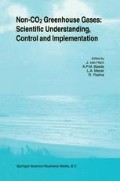Abstract
This study assesses the potential contribution to global warming due to emissions from hydrofluorocarbons (HFCs), perfluorocarbons (PFCs) and sulfur hexafluoride (SF6) until 2100. The emission scenarios start with emissions inferred from atmospheric observations. To project future emissions a top-down approach is chosen. Economic projections are combined with different assumptions about the diffusion of improved technology. The greenhouse impact of emissions of HFCs, PFCs and SF6 in different scenarios is evaluated and compared to the historical contribution from anthropogenic halocarbons. Distinctly different results for the historical emission level are derived depending on which compounds are included and which net values for the global warming potential of halocarbons are used. This implies that the historical radiative effect of greenhouse gas emissions associated with global halocarbon usage can currently not be scientifically defined.
Access this chapter
Tax calculation will be finalised at checkout
Purchases are for personal use only
Preview
Unable to display preview. Download preview PDF.
References
AFEAS, Production and sales report 1996; Alternative Fluorocarbon Environmental Acceptability Study, Science & Policy Associates, Inc., Washington, 1998.
Harnisch, J., R. Borchers, P. Fabian, M. Maiss; Tropospheric trends for CF4 and C2F6 since 1982 derived from SF6 dated stratospheric air, Geophys. Res. Lett., 23, pp. 1099–1102, 1996a.
Harvey, R.; Update on U.S. non-0O2 emissions and emission reduction opportunities; Presentation at the Workshop on Climate Change Impacts and Integrated Assessment; Snowmass, July, 1999.
IPCC; Technical Summary; In: Climate Change 1995 - The science of climate change; Contribution of working group I; The Intergovernmental Panel on Climate Change; Cambridge, 1996.
Maiss, M., L.P. Steele, R.J. Francey, P.J. Fraser, R.L. Langenfelds, N.B.A. Trivett, I. Levin; Sulfur hexafluoride–a powerful new atmospheric tracer; Atm.. Environ., 30, pp. 1621–1629, 1996.
March; Opportunities to minimise emissions of hydrofluorocarbons (HFCs) from the European Union; A study for DG III of the European Commission, March-Consulting-Group, September, 1998.
McFarland, M.; Applications and emissions of fluorocarbon gases: past, present and prospects for the future; Proceedings of the IPCC/TEAP Meeting in Petten, May 1999, ECN, Petten, 1999.
Midgley, P. and A. McCulloch; Production, sales and emissions of halocarbons from industrial sources;; in `Reactive halogen compounds in the atmosphere’ edited by P. Fabian and O. Singh, Handbook of Environmental Chemistry, pp. 155–190, Springer-Verlag, Berlin, 1999.
Oram, D.E., W.T. Sturges, S.A. Penkett, A. McCulloch, P.J. Fraser; Growth of fluoroform (CHF3, HFC23) in the background atmosphere; Geophys. Res. Lett., Vol.. 25, pp. 35–38, 1998.
Reilly, J., R. Prinn, J. Hamisch, J. Fitzmaurice, H. Jacoby, D. Kicklighter, P. Stone, A. Sokolov, C. Wang; Multi-Gas Assessment of the Kyoto Protocol; Nature, in press, 1999.
Simmonds, P.G., D.M. Cunnold, R.F. Weiss, R.G. Prinn, P.J. Fraser, A. McCulloch, F.N. Alyea, S. O’Doherty; Global trends and emission estimates of CC14 from in situ background observations from July 1978 to June 1996; J. Geophys. Res., 103, pp. 16017–16027, 1998.
WMO; Scientific assessment of ozone depletion: 1998; Global Ozone Research and Monitoring Project - Report No. 44, World Meteorological Organization, Geneva, 1999.
Yang, Z., R.S. Eckaus, A.D. Ellermann, H.D. Jacoby; The MIT emissions prediction and policy analysis (EPPA) model; MIT Joint Program on the Science and Policy of Global Change, Report No. 6, 1996. http://web.mit.edu/globalchange/www/rpt6.html
Author information
Authors and Affiliations
Editor information
Editors and Affiliations
Rights and permissions
Copyright information
© 2000 Springer Science+Business Media Dordrecht
About this chapter
Cite this chapter
Harnisch, J., Jacoby, H.D., Prinn, R.G., Wang, C. (2000). Regional Emission Scenarios for HFCs, PFCs and SF6 . In: van Ham, J., Baede, A.P.M., Meyer, L.A., Ybema, R. (eds) Non-CO2 Greenhouse Gases: Scientific Understanding, Control and Implementation. Springer, Dordrecht. https://doi.org/10.1007/978-94-015-9343-4_35
Download citation
DOI: https://doi.org/10.1007/978-94-015-9343-4_35
Publisher Name: Springer, Dordrecht
Print ISBN: 978-90-481-5409-8
Online ISBN: 978-94-015-9343-4
eBook Packages: Springer Book Archive

